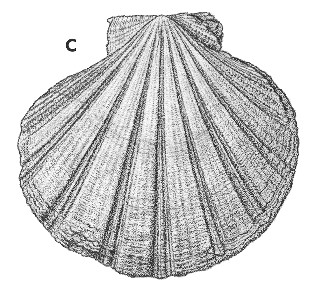
Revised descriptions of New Zealand Cenozoic Mollusca from Beu and Maxwell (1990)

 | Revised descriptions of New Zealand Cenozoic Mollusca from Beu and Maxwell (1990) | 
|
  (Pl. 33c): GS12184, CH/f2C, Momoe-a-Toa Shellbed, northern Chatham Island, early Opoitian (GNS) |
Beu & Maxwell (1990): Chapter 14; p. 276; pl. 33 c.
Synonymy: Sectipecten allani Marwick 1928, p. 459
Classification: Pectinidae
Description: Moderately large for family (90-110 mm high), calcitic, length equal to height in small specimens and in finely costate large shells, but length markedly greater than height in many coarsely costate large specimens; left valve slightly more inflated than right. Ears almost equal in 2 valves, nearly symmetrical; anterior margin of anterior ears sinuous, with broad, shallow byssal sinus but no ctenolium in right valve. Sculpture of 8 to 11 (9 or 10 on most specimens) wide, flat-topped, square-edged radial folds on right valve and a similar number of high, narrow, widely spaced folds on left valve of coarsely sculptured end-members, with 2 or 3 low, square-edged, secondary costae in each interspace; a similar number of lower, narrower, medially subdivided folds tending to fade out towards ventral margin and with more numerous lower, flat-topped secondary costae on right valve of more finely sculptured end-members; right valve of younger (Waipipian-Mangapanian) forms develops a deep subdividing groove down the centre of major costae, and corresponding central narrow costa in wide interspaces on left valve.
Comparison: The type population of Sectipecten allani is very complex, and fortunately thousands of specimens can be observed on an extensive bedding plane. The finely and coarsely sculptured end-members are linked by a complete range of intermediates, and range from shells resembling S. grangei (Tongaporutuan; Pl. 28c) to extreme, flat-ribbed S. allani. The lineage continued to evolve gradually into a slightly more subdivided form (Opoitian-Mangapanian of mainland New Zealand) occurring only rarely in barnacle limestone, conglomerate, and coarse, near-shore sandstone, and almost all known specimens (other than at Momoe-a-Toa) are undiagnostic left valves. Some relatively simplely sculptured right valves are known from a Mangapanian limestone in the Buxton Stream, Blythe Valley, near Cheviot, North Canterbury, and a single excellent, articulated specimen from a conglomeratic shellbed in Greeks Creek, Arahura Valley, Westland (Waipipian; Otago University Geology Department, OU11904) shows that advanced right valves have the major folds subdivided by a deep groove, a new character in the lineage. The Sectipecten lineage largely disappeared from the record after early Opoitian time, apparently because it became adapted to progressively more near-shore, high-energy environments through Pliocene time. However, this is another case of a classic anagenetic series that is difficult to subdivide into species in a reliable way.
Distribution: Opoitian-Mangapanian; Momoe-a-Toa Shellbed, near Cape Young, northern Chatham Island, early Opoitian (type); Opoitian specimens are known from a few mainland localities (Kaawa Creek, southwest Auckland; Dyerville Limestone, northern Aorangi Range, southern Wairarapa), Waipipian specimens are known from equally few localities (Black Reef Sandstone, Cape Kidnappers; conglomeratic shellbed near head of Greek's Creek, Arahura Valley, Westland) and specimens are not uncommon at one Mangapanian locality (rubbly limestone in Buxton Stream, Blythe Valley, North Canterbury; with Phialopecten thomsoni). Carter (1972) recorded a single early Nukumaruan specimen from the Pohangina district, eastern Wanganui basin, but it is uncertain whether this is a reworked older specimen.
Cite this publication as: "A.G. Beu and J.I. Raine (2009). Revised
descriptions of New Zealand Cenozoic Mollusca from Beu and Maxwell (1990). GNS
Science miscellaneous series no. 27."
© GNS Science, 2009
ISBN
978-0-478-19705-1
ISSN 1177-2441
(Included with a PDF facsimile file
copy of New Zealand Geological Survey Paleontological Bulletin 58 in CD version
from: Publications Officer, GNS Science, P.O. Box 30368 Lower Hutt, New
Zealand)